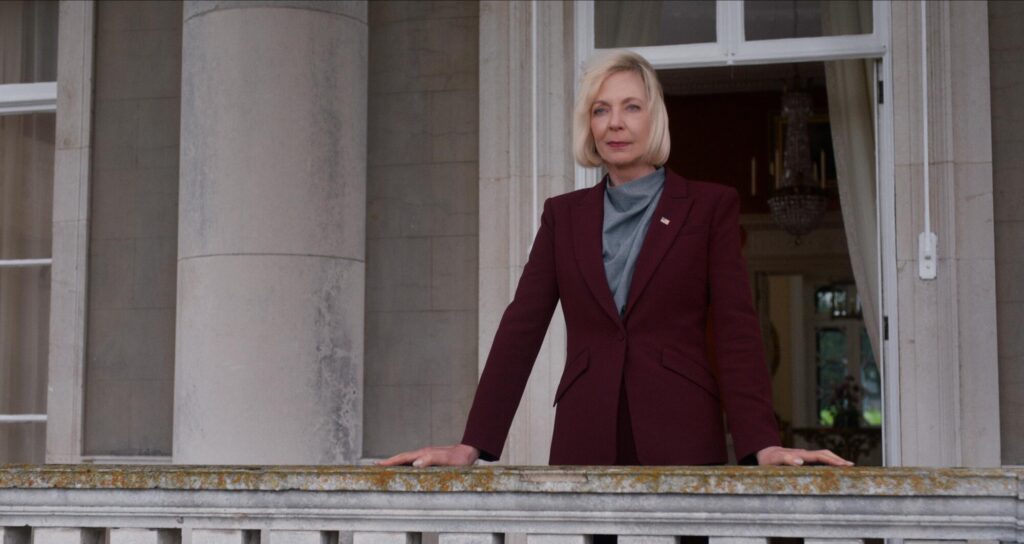Feedback is the seasoning that flavors the success of our favorite TV shows. Whether it’s from an executive, a trusted colleague or the actors, advice can shape tone, pacing, plotlines and character arcs — all of which can make or break a series. We asked some of this year’s Emmy contenders how creative collaborations provided the notes to their success.
“The Diplomat”
Allison Janney in “The Diplomat.”
(Netflix)
To create the unrelenting tension in the Netflix political drama, which was inspired by conversations with real diplomats, creator Debora Cahn turned to advice from “Homeland” showrunner Alex Gansa: “He said take whatever story that you’re planning in the last episode of the first season and do it in the first episode. And I was like, ‘Ooh, s—.’” The result hurls lead Kate Wyler (Keri Russell) into high-stakes chaos, none wilder than her clash with the vice president (Allison Janney) and a jaw-dropping Season 2 twist. “I was embarrassed to pitch it to the writers’ room. It was an unspeakably dumb idea and a bad cliche, but I had to get it off my chest. We looked for other things, but we kept coming back to it and realized that it did the thing that you really want a plot to do, which is it changes everything.”
“Monsters: The Lyle and Erik Menendez Story”
Nicholas Alexander Chavez, left, Cooper Koch and Javier Bardem in “Monsters: The Lyle And Erik Menendez Story.”
(Miles Crist / Netflix)
“In researching [the Menendez brothers case], [co-creator] Ryan [Murphy] mentioned, ‘I think this story is [Akira Kurosawa’s] “Rashomon.”’ That was the one note I was like, ‘Oh, I totally get this now,’” says co-creator Ian Brennan of the Netflix limited series. “We’re never going to know what the true story is, but that became a really good guiding light because we made sure that when we’re telling an aspect of this story that’s disputed, we’d go back and tell it the other way,” he says. “What we’re doing is based on as much truth as we can find, but I feel like you’re obliged to take some liberty. It’s not only to tell a story that’s entertaining but to get to those deeper truths that are sometimes occluded by the mundanity of some facts. It’s a painting, not a photograph.”
“Only Murders in the Building”
Steve Martin, left, Selena Gomez and Martin Short in “Only Murders in the Building.”
(Eric McCandless / Disney)
Creator John Hoffman says the idea for Hulu’s mystery-comedy came to him during the pandemic, when everyone was afraid to step outside their door. “This show is about lonely New Yorkers who found a connection between true crime and a death in their building,” he says. But his chief concern was injecting soul into the punch lines. “When I was talking about my ideas for how to make it more connective and humorous, I wanted the comedy to come from humanity as opposed to jokes and behavior. I was deeply surprised by everyone’s response, from the studio, the network and [executive producer] Dan Fogelman, that they wanted to lean into that more profound connective tissue that was more unexpected and dramatic at times,” he says. “There are a lot of personal things in that first season that I thought, ‘Well, that’s going to get me fired.’ But they accepted it.”
“Slow Horses”
Gary Oldman in “Slow Horses.”
(Apple TV+)
“[Executive producer] Graham Yost was always very clear that we should focus on adapting Mick Herron’s work and not just use it as a launchpad for some kind of offshoot,” says creator Will Smith of the clever Apple TV+ show, which follows a group of disgraced MI5 agents. “Whenever we got stuck in the room, Graham’s watchword would be, ‘Well, let’s look at what Mick wrote,’ and we would go back to the book and figure it out from there. So the tone of the books infused the scripts.” The outcome is a nail-biter of a tale with humor smuggled in like contraband. ”Our fabulous exec Jamie Laurenson and our brilliant [Season 1] director James Hawes both understood that nothing should ever feel like a joke, nothing should feel gratuitous or crowbarred for a laugh. It should all be thrown away, underplayed, said on the run.”
“What We Do in the Shadows”
The cast of “What We Do in the Shadows.”
“There’s a part of me that feels like it’s cheating, but it really helps,” says showrunner Paul Simms of the mockumentary shooting style behind the hilarious FX series, which portrays the awkward lives and bizarre pitfalls of centuries-old vampires. “If you’re writing a narrative show that’s not documentary format, people’s motivations have to come out in their dialogue. With this, you can have characters very directly and, in a very funny way, state their motivations.” Unlocking its full bite of wit were two keys. “One great thing about this format is that you’re not hamstrung by little continuity details in the edit. You can do jump cuts and jam in as much funny stuff without having to worry,” Simms says. The other, a network note: “From the beginning, FX and John Landgraf were saying the vampire stuff is fun, but it can’t be all vampire jokes. So our approach every season was to go in new directions and create constant tension.”
